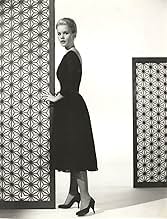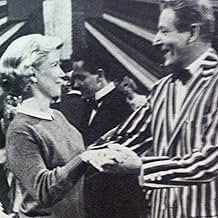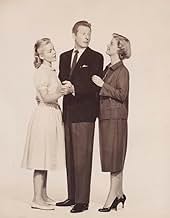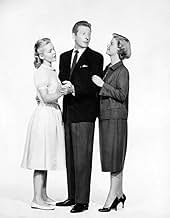IMDb-BEWERTUNG
7,1/10
2221
IHRE BEWERTUNG
Danny Kaye legt mit seinem Markenzeichen, der Clownerie, los. Louis "Satchmo" Armstrong spielt sein Horn und singt mit seiner berühmten, gurgelnden Granitstimme.Danny Kaye legt mit seinem Markenzeichen, der Clownerie, los. Louis "Satchmo" Armstrong spielt sein Horn und singt mit seiner berühmten, gurgelnden Granitstimme.Danny Kaye legt mit seinem Markenzeichen, der Clownerie, los. Louis "Satchmo" Armstrong spielt sein Horn und singt mit seiner berühmten, gurgelnden Granitstimme.
- Für 4 Oscars nominiert
- 2 Gewinne & 8 Nominierungen insgesamt
Eric Alden
- Musician
- (Nicht genannt)
Babette Bain
- Rehabilitation Patient
- (Nicht genannt)
Bill Baldwin
- Announcer
- (Nicht genannt)
Sheryn Banks
- Girl at Birthday Party
- (Nicht genannt)
Earl Barton
- Choreographer
- (Nicht genannt)
Henry Beau
- Undetermined Secondary Role
- (Nicht genannt)
Empfohlene Bewertungen
10neal-57
This little gem can be appreciated on two levels. Non-jazz fans who have never heard of Red Nichols will find a fine little "family movie," which despite its 192O's-speakeasy milieu offers up nothing seamier than the observation by Red's wife, Bobbi (Barbara Bel Geddes in a performance of remarkable warmth) that their daughter has come to believe that "breakfast is a cup of coffee and an aspirin." The story of the daughter's attack of polio and her fight to walk again is unflinching and the first-time viewer should pack sufficient Kleenex. Fans of Danny Kaye will find plenty of examples of his trademark clowning, but they'll also find moments of wonderful dramatic and introspective acting.
The most remarkable scene in the movie: a guilty Nichols/Kaye, feeling that his daughter's polio is the direct result of his neglect of her in favor of jazz, promises God that if she survives, he will give up music and devote himself to her care. Sound hokey? Could have been. But the scene where Kaye throws his cornet into the river is absolutely spine-chilling. He stops, tenderly caressing the cornet keys, allowing the happy memories to pass wistfully over his features...then coldly, abruptly, tosses the instrument into the waters below. When Kaye straightens up, he seems to have aged twenty years and gained fifty pounds...a remarkable scene.
The second level on which the film can be appreciated: an introduction to a wonderful musician. Like "The Glenn Miller Story" and "The Benny Goodman Story," "The Five Pennies" makes little attempt to give an accurate portrayal of its subject. Ernest Loring Nichols, from all accounts, was a cool, calculating businessman, nothing like the madcap, freewheeling character played by Danny Kaye. As a cornetist he stood willingly in the shadow of his idol Bix Beiderbecke, whose playing style he strove (with some success) to duplicate. Despite the fact that Bix was the major personal and professional influence on Red, he is mentioned only once, toward the end of the film: "(in those early days) there was Louis (Armstrong), Bix and me--and that was it!"
Biographical inaccuracies aside, the pure tone of the real Nichols' cornet shines through brilliantly, and reaches out to grab the ear of the traditional jazz fan--at least it did mine. When I first saw the film in '81, I was a Glenn Miller and Benny Goodman fan, and knew Nichols only as a bandleader they had played with early on. The movie was a springboard, leading me to search out the albums, and the real biographical details, of the very real Red Nichols.
Incidentally, the film benefited the by-then largely forgotten Nichols greatly: just as the late-5O's dixieland-revival was gathering steam, he landed a Columbia contract, and recorded some wonderful stereo albums of his past hits--and of the music specially written for the film by Silvia Fine (Mrs. Danny Kaye). Though he died in '65 (while in Vegas to play a gig), his music lives on through these wonderful albums --and through the soundtrack on Decca, featuring not only Nichols but Louis Armstrong. Their duets, through placed in fictionalized scenes, stand as a legitimate audio document of two of the earliest and most influential cornetist/trumpeters in history playing together--in glorious, analog stereo. I'll join the others who've commented on this film in wishing that this wonderful soundtrack would be released on CD. (Not outside the realm of possibility: the soundtrack of "Pete Kelly's Blues, from the same time period, has just appeared on CD...so who knows?)
For both traditional jazz fans, and those who appreciate wholesomely uplifting (but NOT goody-goody) film, this movie is a treasure.
The most remarkable scene in the movie: a guilty Nichols/Kaye, feeling that his daughter's polio is the direct result of his neglect of her in favor of jazz, promises God that if she survives, he will give up music and devote himself to her care. Sound hokey? Could have been. But the scene where Kaye throws his cornet into the river is absolutely spine-chilling. He stops, tenderly caressing the cornet keys, allowing the happy memories to pass wistfully over his features...then coldly, abruptly, tosses the instrument into the waters below. When Kaye straightens up, he seems to have aged twenty years and gained fifty pounds...a remarkable scene.
The second level on which the film can be appreciated: an introduction to a wonderful musician. Like "The Glenn Miller Story" and "The Benny Goodman Story," "The Five Pennies" makes little attempt to give an accurate portrayal of its subject. Ernest Loring Nichols, from all accounts, was a cool, calculating businessman, nothing like the madcap, freewheeling character played by Danny Kaye. As a cornetist he stood willingly in the shadow of his idol Bix Beiderbecke, whose playing style he strove (with some success) to duplicate. Despite the fact that Bix was the major personal and professional influence on Red, he is mentioned only once, toward the end of the film: "(in those early days) there was Louis (Armstrong), Bix and me--and that was it!"
Biographical inaccuracies aside, the pure tone of the real Nichols' cornet shines through brilliantly, and reaches out to grab the ear of the traditional jazz fan--at least it did mine. When I first saw the film in '81, I was a Glenn Miller and Benny Goodman fan, and knew Nichols only as a bandleader they had played with early on. The movie was a springboard, leading me to search out the albums, and the real biographical details, of the very real Red Nichols.
Incidentally, the film benefited the by-then largely forgotten Nichols greatly: just as the late-5O's dixieland-revival was gathering steam, he landed a Columbia contract, and recorded some wonderful stereo albums of his past hits--and of the music specially written for the film by Silvia Fine (Mrs. Danny Kaye). Though he died in '65 (while in Vegas to play a gig), his music lives on through these wonderful albums --and through the soundtrack on Decca, featuring not only Nichols but Louis Armstrong. Their duets, through placed in fictionalized scenes, stand as a legitimate audio document of two of the earliest and most influential cornetist/trumpeters in history playing together--in glorious, analog stereo. I'll join the others who've commented on this film in wishing that this wonderful soundtrack would be released on CD. (Not outside the realm of possibility: the soundtrack of "Pete Kelly's Blues, from the same time period, has just appeared on CD...so who knows?)
For both traditional jazz fans, and those who appreciate wholesomely uplifting (but NOT goody-goody) film, this movie is a treasure.
10sdhalfon
my favorite bit of this film is at the end, I care not how factual it is. I find a lump in my throat every single time I see it and I am usually blubbing like a baby by the end credits. It is a wonderful story of a very talented man and of a great time in musical history, the scenes with 'Satchmo' Louis Armstrong are another particular favorite as he usually steals the scene. The little girl actress put s in a fine and mature performance as 'Red' Nicols's daughter. But as usual Danny Kaye is nothing short of majestic he is perfectly at home miming to Lorne 'Red' Nicols cornet playing. The story is beautiful as is the acting. Don't forget to pack your Kleenex when you watch it though. Excellent family entertainment twenty out of ten......
This is an odd one.
I look back on 'The Five Pennies' in two parts. The first half of the film is uninteresting and slow, but once the story gets set and the second half comes to fruition it turns into something rather touching - which I didn't expect at all. By the end, I felt truly attached to the characters and their story - but that's weird, given how I didn't enjoy the early stages.
Danny Kaye is very good in the lead role of Red, especially towards the end. Susan Gordon (Dorothy, as a kid) impressed me a bunch, she has one fantastic poker scene with Kaye. Barbara Bel Geddes, meanwhile, plays the role of Willa well.
The film, a loose biopic on the real Red Nichols, is music-heavy. Early on I think that affects things from a film point of view, but you can at least tell the cast - particularly Kaye and Louis Armstrong (as himself) - are having a fun time.
Overall, I think it's lovely - but I can't recall a film that's split my feelings from start-to-finish as much as this did.
I look back on 'The Five Pennies' in two parts. The first half of the film is uninteresting and slow, but once the story gets set and the second half comes to fruition it turns into something rather touching - which I didn't expect at all. By the end, I felt truly attached to the characters and their story - but that's weird, given how I didn't enjoy the early stages.
Danny Kaye is very good in the lead role of Red, especially towards the end. Susan Gordon (Dorothy, as a kid) impressed me a bunch, she has one fantastic poker scene with Kaye. Barbara Bel Geddes, meanwhile, plays the role of Willa well.
The film, a loose biopic on the real Red Nichols, is music-heavy. Early on I think that affects things from a film point of view, but you can at least tell the cast - particularly Kaye and Louis Armstrong (as himself) - are having a fun time.
Overall, I think it's lovely - but I can't recall a film that's split my feelings from start-to-finish as much as this did.
... but I could never see the movie yet. Still, it partly saved my life when I was dying of a very bad pneumonia and was floating in between the two worlds. I didn't yet understand English, but the soundtrack of The Five Pennies played on the vinyl record (don't ask me how my Finnish parents got to possess it) went through my conscience and kept me on the living side. I can still sing one voice of the lullaby hearing Danny Kaye and Louis Armstrong singing the other voices in my head. I'm lucky to be able to hear them without any technical device.
Now, by a coincidence I fall on this movie I never saw - so important in my life - on VHS / NTSC in Amazon. I live in Europe... No way being able to see it. Do you really mean that there's no DVD of it yet ? I seem to be not the only one wishing for it.
Now, by a coincidence I fall on this movie I never saw - so important in my life - on VHS / NTSC in Amazon. I live in Europe... No way being able to see it. Do you really mean that there's no DVD of it yet ? I seem to be not the only one wishing for it.
When I was growing up Danny Kaye was a huge figure.All over the radio,on records TV and the movies,you couldn't escape from his face or voice. He made successful tours of top rate theatrical venues in the uk,he could sing,dance,act,write comedy routines and song lyrics.His stage act was an explosion of energy and sheer talent.He was-in the ludicrously overused sense of the term-a superstar. In "The Five Pennies" we catch him at the height of his powers as an actor,singer and lyricist(to his wife Sylvia Fine's enchanting tunes) With a strong guest appearance by arguably the finest jazz musician who ever lived and some really clever songs(The Five Pennies,Lullaby in Ragtime and Goodnight all use the same chord sequence). It was a success de cash rather than a success d'estime like most of Kaye's movies,and perhaps that's why his work is largely neglected in critical circles today. As Gloria Swanson said in "Sunset Boulevard,"I'm still big,the movies got smaller"
Wusstest du schon
- WissenswertesWhile Danny Kaye worked hard to be able to accurately fake playing cornet (he practiced for months learning the fingering of the instrument), it was the real Red Nichols who provided all of the cornet playing for Kaye in this movie.
- PatzerAfter Red and Willa have left the club and are traveling home, the cars seen through the rear window of the taxicab are distinctly 1940's to 1950's vehicles which were nonexistent in 1924.
- Zitate
Louis Armstrong: Excuse it, folks. Somebody must have put alcohol in our liquor.
- VerbindungenFeatured in American Masters: Danny Kaye: A Legacy of Laughter (1996)
- SoundtracksThe Five Pennies
(1959)
Words and Music by Sylvia Fine
Sung by Danny Kaye (uncredited) to Dorothy
Performed by Eileen Wilson (uncredited) at the comeback show
Top-Auswahl
Melde dich zum Bewerten an und greife auf die Watchlist für personalisierte Empfehlungen zu.
- How long is The Five Pennies?Powered by Alexa
Details
- Erscheinungsdatum
- Herkunftsland
- Sprache
- Auch bekannt als
- The Five Pennies
- Drehorte
- Produktionsfirma
- Weitere beteiligte Unternehmen bei IMDbPro anzeigen
- Laufzeit
- 1 Std. 52 Min.(112 min)
- Seitenverhältnis
- 1.85 : 1
Zu dieser Seite beitragen
Bearbeitung vorschlagen oder fehlenden Inhalt hinzufügen





































